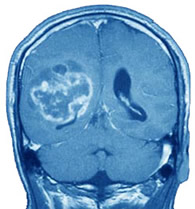News Release: Research, School of Medicine, Winship Cancer Institute
Feb. 11, 2009
Tool to Shrink Brain Tumors' Blood Supply Identified
 Brain scan showing glioblastoma
Brain scan showing glioblastomaWhen scientists are looking for ways to block brain tumors' growth, tools the brain uses itself are ideal. That’s the rationale behind Emory researchers’ work with vasculostatin, a fragment of a naturally occurring protein in the brain.
Vasculostatin can prevent tumors implanted in the brains of rats from expanding their blood vessels, according to results published in the Feb. 1 issue of Cancer Research.
"This is a proof of principle, showing that vasculostatin can act as a very potent blocker of new blood vessel formation and tumor growth," says senior author Erwin Van Meir, PhD, professor of neurosurgery and hematology and medical oncology at Emory's Winship Cancer Institute.
The first author was Balveen Kaur, PhD, now assistant professor of neurosurgery at Ohio State University, who discovered vasculostatin while working in Van Meir's laboratory.
The research team showed that vasculostatin could push back against the “worst of the worst”: brain tumor cells with an extra gene driving angiogenesis, the formation of new blood vessels. Tumors require their own blood vessels to grow past a certain size.
The researchers showed that vasculostatin reduces the density of blood vessels in aggressive human brain tumors implanted in rats' brains. In collaboration with investigators at the Cleveland Clinic, they showed that it acts through CD36, a molecule found on cells that line blood vessels.
The team's experiments gauged the therapeutic effects of putting the gene for vasculostatin into brain tumor cells. In contrast, to administer vasculostatin to people with brain cancer, a small piece of the protein would be injected or introduced intravenously, Van Meir says. More research is necessary to figure out which piece and how, he says.
Vasculostatin is a fragment of a protein called brain angiogenesis inhibitor 1 (BAI1), first identified in 1997 by scientists at the University of Tokyo.
In a way, BAI1 was an answer to a question posed by Van Meir's research in the 1990s on p53, a gene that normally prevents cancer and is often mutated in tumors. He had shown that p53 stimulates cells in the brain to make a natural inhibitor of angiogenesis – but the identity of the inhibitor(s) remained unknown until BAI1 was identified as a candidate.
BAI1 is normally stuck on the surfaces of cells such as astrocytes in the brain, but vasculostatin can diffuse to neighboring cells. What makes vasculostatin break itself off from the rest of BAI1 is still an active area of investigation, Van Meir says.
The research was supported by the National Institutes of Health, the National Brain Tumor Foundation, the American Heart Association, the Scott Hamilton Cares Foundation and Alex’s Lemonade Stand Foundation.
Reference:
B. Kaur et al. Vasculostatin inhibits intracranial glioma growth and negatively regulates in vivo angiogenesis through a CD36-dependent mechanism. Cancer Res 69: 1212-20 (2009).
###
The Robert W. Woodruff Health Sciences Center of Emory University is an academic health science and service center focused on missions of teaching, research, health care and public service. Its components include schools of medicine, nursing, and public health; Yerkes National Primate Research Center; the Emory Winship Cancer Institute; and Emory Healthcare, the largest, most comprehensive health system in Georgia. The Woodruff Health Sciences Center has a $2.3 billion budget, 17,000 employees, 2,300 full-time and 1,900 affiliated faculty, 4,300 students and trainees, and a $4.9 billion economic impact on metro Atlanta.
Learn more about Emory’s health sciences:
Blog: http://emoryhealthblog.com
Twitter: @emoryhealthsci
Web: http://emoryhealthsciences.org
